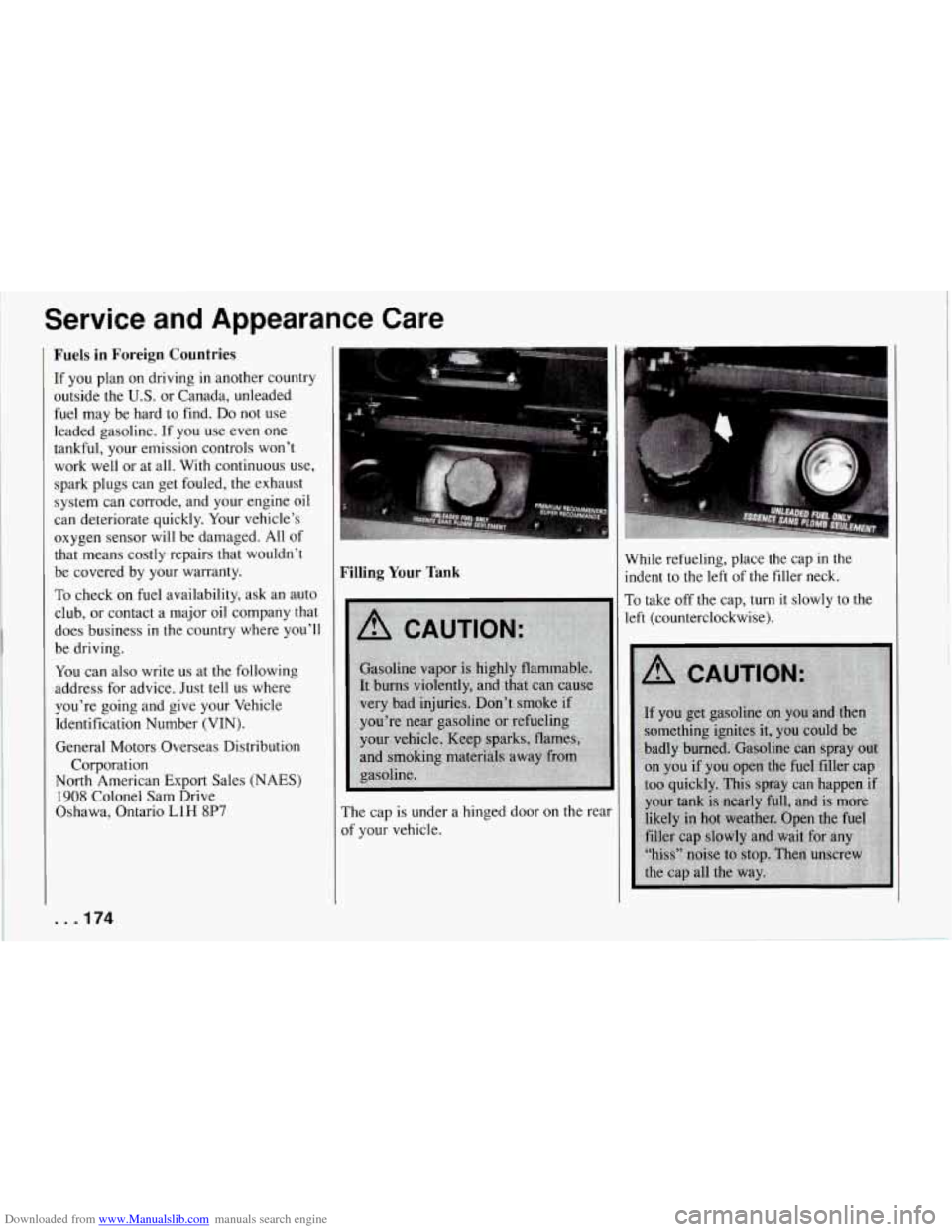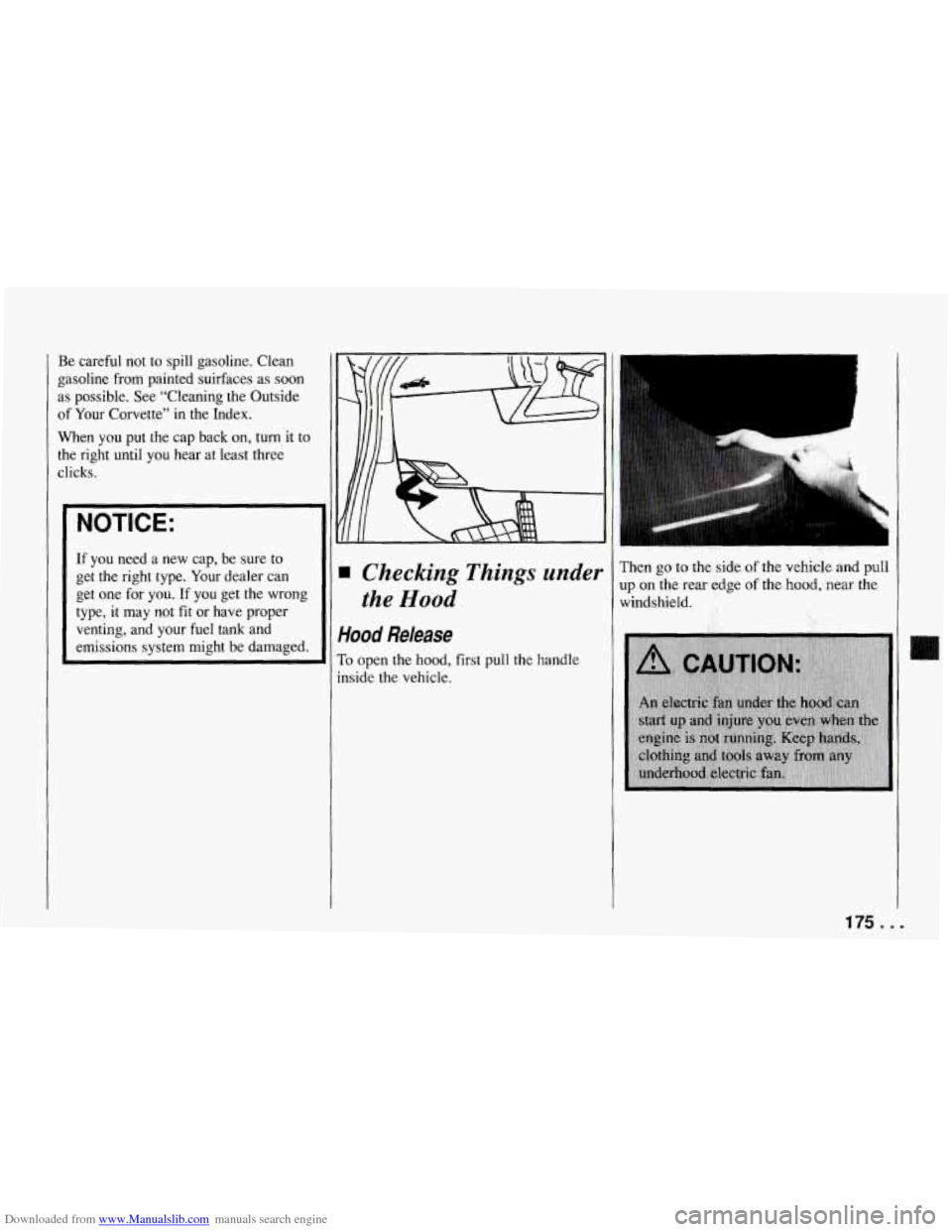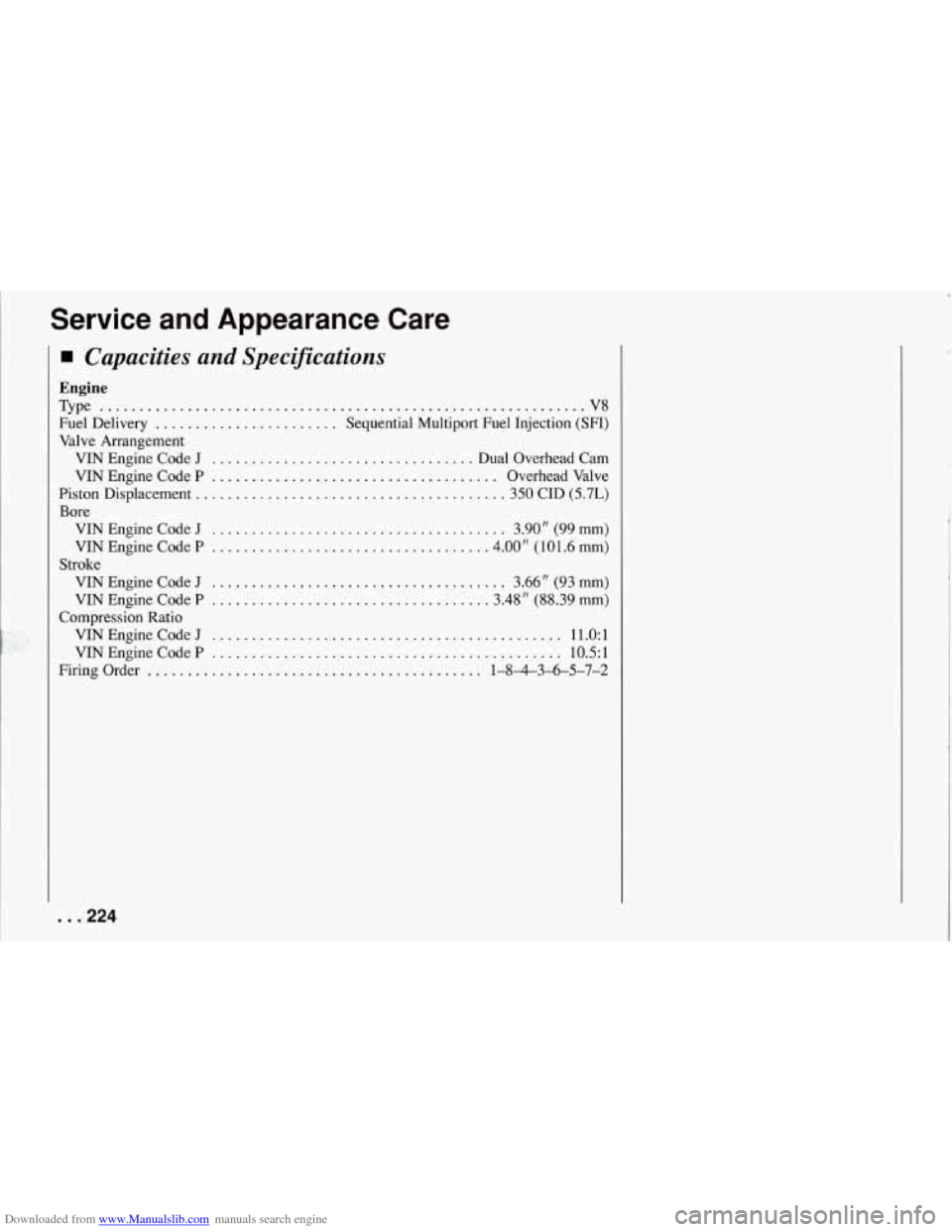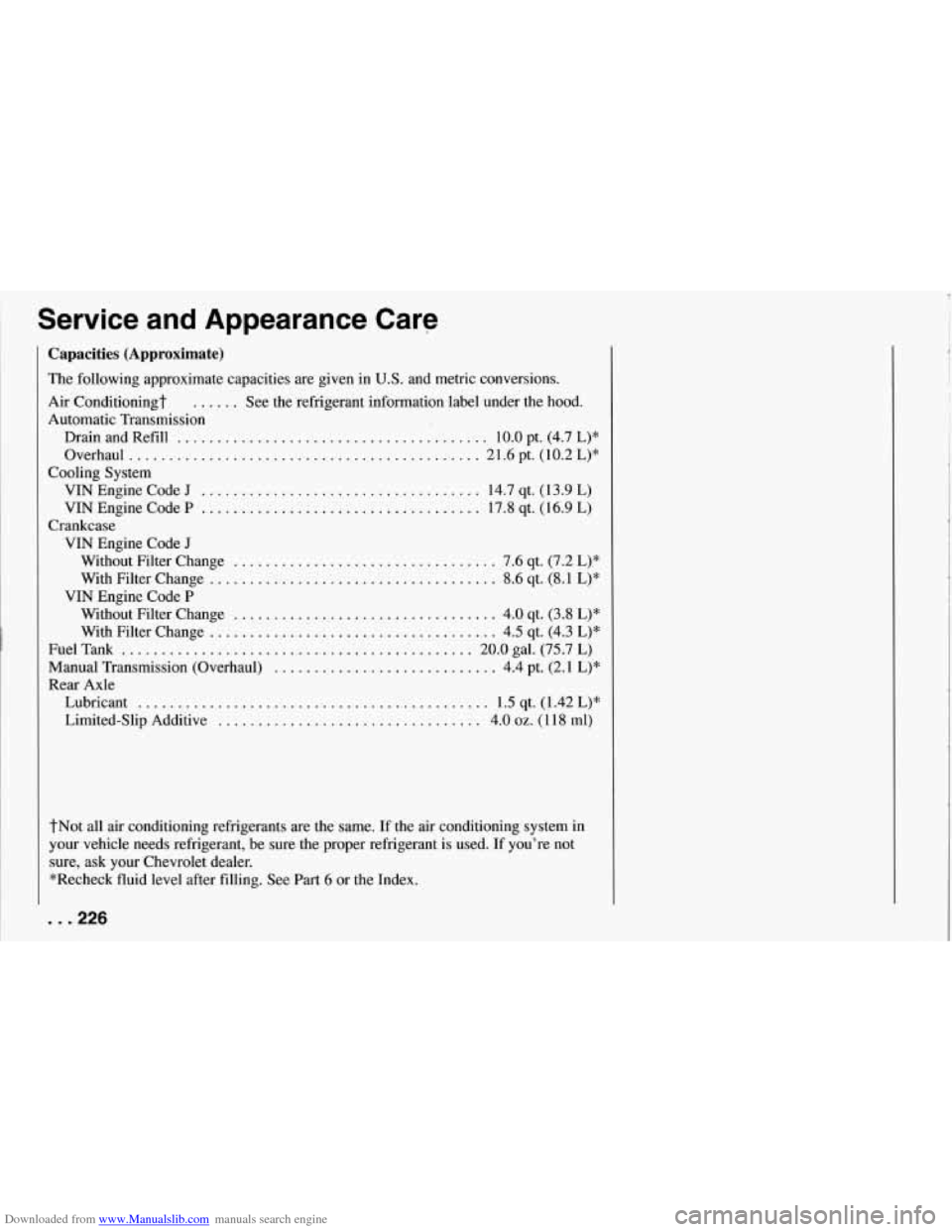1994 CHEVROLET CORVETTE fuel cap
[x] Cancel search: fuel capPage 85 of 274

Downloaded from www.Manualslib.com manuals search engine Features and Controls
It takes more (or less) fuel to fill up
than the gauge reads. For example, the
gauge reads half full, but it took more
(or less) than half of the tank’s
capacity to fill it.
The gauge moves a little when you
turn, stop or speed up.
You can use the Trip Monitor to display
more detailed fuel information. Each time
you press “FUEL INFO,” one
of the
following will appear next to the fuel
gauge.
INST The fuel economy calculated
for your current driving conditions.
AVERAGE: The fuel economy
calculated for the current tank of fuel,
or since you last reset the display.
RANGE: The distance you can drive
before refueling.
Blank: The fuel gauge is displayed
alone.
You should reset the fuel information
display every time you refuel. Press
“RESET FUEL” on the Trip Monitor. :loser to the floor.
It may
take longer to
stop. If the light is still on, have the
vehicle towed for service. (See “Towing
Your Vehicle” in the Index.)
... 84
Brake System Warning Light
Your Corvette’s hydraulic brake system
is divided into two parts. If one part isn’t
working, the other part can still work and
stop you. For good braking, though, you
need both parts working well.
This light should come on as you start thc
vehicle. If it doesn’t come on then, have
it fixed
so it will be ready to warn you if
there’s a problem. If this warning light
stays on, there could be
a brake problem.
Have your brake system inspected right
away.
If the light comes on while you are
driving, pull
off the road and stop
carefully. You may notice that the pedal
is harder to push. Or, the pedal may go
Page 172 of 274

Downloaded from www.Manualslib.com manuals search engine Here you will find information
about the care of your Corvette
.
This part begins with service
and fuel information. and then it
shows how
to check important
fluid and lubricant levels
. There
is also technical information
about your vehicle. and a section devoted
to its
appearance care
.
Part 6
Service & Appearance Care
Service ........................................................
Fuel ..........................................................
Checking Things under the Hood ...................................
HoodRelease .................................................
Engineoil .................................................
Aircleaner ........................... ...................
Automatic Transmission Fluid ..................................
Manual Transmission Fluid ......................................
Hydraulic Clutch ...............................................
RearAxle ....................................................
Enginecoolant ................................................
Power Steering Fluid ...........................................
Windshield Washer Fluid ........................................
Brake Master Cylinder ..........................................
Battery ......................................................
Bulb Replacement ...............................................
Windshield Wiper Blades ..........................................
Tires ..........................................................
Appearancecare ................................................
Appearance Care Materials Chart ...................................
Vehicle Identification Number (VIN) ................................
Service Parts Identification Label ...................................
Add-on Electrical Equipment ......................................
Fuses and Circuit Breakers ........................................
Replacement Bulbs ..............................................
Capacities and Specifications ...................................
LoadingYourVehicle ............................................
172
173
175
175
178
182 184
186
187
188
188
191
192
193
195
195
202
202
204
210
217
218
218
218
219
223
224
171 ..
Page 175 of 274

Downloaded from www.Manualslib.com manuals search engine Service and Appearance Care
Fuels in Foreign Countries
If you plan on driving in another country
outside the
U.S. or Canada, unleaded
fuel may be hard to find.
Do not use
leaded gasoline. If you use even one
tankful, your emission controls won’t
work well or at all. With continuous use,
spark plugs can get fouled, the exhaust
system can corrode, and your engine oil
can deteriorate quickly. Your vehicle’s
oxygen sensor will be damaged. All of
that means costly repairs that wouldn’t
be covered by your warranty.
To check on fuel availability, ask an auto
club, or contact a major oil company that
does business
in the country where you’ll
be driving.
You can also write us at the following
address for advice. Just tell
us where
you’re going and give your Vehicle
Identification Number (VIN).
General Motors Overseas Distribution
North American Export Sales
(NAES)
1908 Colonel Sam Drive
Oshawa, Ontario LlH 8P7
Corporation
. . .174
Filling
Your Tank
The cap is under a hinged door on the rear
of your vehicle. While
refueling, place the cap in the
indent to the left of the filler neck.
To take
off the cap, turn it slowly to the
left (counterclockwise).
Page 176 of 274

Downloaded from www.Manualslib.com manuals search engine Be careful not to spill gasoline. Clean
5asoline from painted suirfaces
as soon
1s possible. See “Cleaning the Outside
If Your Corvette’’ in the Index.
When you put the cap back on, turn it to
:he right until you hear at least three
:licks.
NOTICE:
If you need a new cap, be sure to
get the right type. Your dealer can
get one for you.
If you get the wrong
type, it may not fit or have proper
venting, and your fuel tank and
emissions system might be damaged.
I Checking Things under
the Hood
Hood Release
ro open the hood, first pull the handle
inside the vehicle.
L
Fhen go to the side of the vehicle and pull
~p on the rear edge of the hood, near the
windshield.
175 ...
Page 204 of 274

Downloaded from www.Manualslib.com manuals search engine MFD BY GENERAL MOTORS CORP.
01/91 5713LB 2503LB DATE GVWR
GAWRFRT GAWRRR
The other label is the Certification label,
found on the rear edge of the driver’s
door. It tells you the gross weight
capacity of your vehicle, called the
GVWR (Gross Vehicle Weight Rating).
The GVWR includes the weight of the
vehicle, all occupants,
fuel and cargo.
Never exceed
the GVWR for your
vehicle, or the Gross Axle Weight Rating
(GAWR) for either the front or rear axle.
And, if you do have a heavy load, you
should spread it out. Don’t carry more
than
100 pounds (45 kg) in your rear area.
I NOTICE:
I
Your warranty does not cover parts or
components that fail because of over-
loading.
~~
If you put things inside your vehicle -
like suitcases, tools, packages, or
anything else
- they will go as fast as the
vehicle goes. If you have to stop or
turn
quickly, or if there is a crash, they’ll keep
going.
203. . .
Page 207 of 274

Downloaded from www.Manualslib.com manuals search engine Service and Appearance Care
Inflation - Tire Pressure
The Tire-Loading Information label which is on the driver’s door shows the correct
inflation pressures for your tires, when they’re cold. “Cold” means your vehicle has
been sitting for at least three hours or driven no more than a mile.
For competitive driving or high-speed driving (over
150 mph or 240 krn/h), make
sure your tires are inflated to
35 psi (240 kPa). When you end this type of driving,
reduce the “cold” inflation pressures (if necessary) to those listed
on the
Tire-Loading Information label.
NOTICE:
Don’t let anyone tell you that underinflation or overinflation is all right. It’s not.
If your tires don’t have enough air (underinflation) you can get:
0 Too much flexing
0 Too much heat
0 Tire overloading
0 Bad wear
0 Bad handling
Bad fuel economy.
If your tires have too much air (overinflation), you can get:
Unusual wear
Bad handling
0 Rough ride
Needless damage from road hazards.
When to Check: Check your tires
mce
a month or more. Don’t forget
your compact spare tire. It should be at
50 psi (420 Wa).
How to Check: Use a good quality
pocket-type gauge to check tire
pressure. Simply looking at the tires
will not tell you the pressure,
=specially if you have radial tires
-
which may look properly inflated even
if they’re underinflated.
Lf your tires have valve caps, be sure to
put them back on. They help prevent
leaks by keeping out dirt and moisture.
Tire Rotation
I’he tires on your Corvette are
lirectional, asymmetrical, and are
different sizes front to rear. Due to this,
your tires should not be rotated. Each
tire and wheel should be used only in
the position it is in.
. . .206
Page 225 of 274

Downloaded from www.Manualslib.com manuals search engine Service and Appearance Care
Capacities and Specifications
Engine
Type ............................................................. V8
Fuel Delivery
....................... Sequential Multiport Fuel Injection (SFI)
Valve Arrangement VIN Engine Code
J ................................. Dual Overhead Cam
VIN Engine Code
P .................................... Overhead Valve
Piston Displacement ....................................... 350 CID (5.7L)
Bore
VIN Engine Code
J ..................................... 3.90" (99 mm)
VIN Engine Code P .................................. .4.00" (101.6 mm)
VIN Engine Code
J ..................................... 3.66" (93 mm)
VIN Engine Code
P .................................. .3.48" (88.39 mm)
VIN Engine Code
J ............................................ 11 .O: 1
VIN Engine Code
P ............................................ 10.5: 1
Firingorder .......................................... 1-843-6-5-7-2
Stroke
Compression Ratio
.. .224
Page 227 of 274

Downloaded from www.Manualslib.com manuals search engine l Service and Appearance Care
Capacities (Approximate)
The following approximate capacities are given in U.S. and metric conversions.
Air Conditioningt
...... See the refrigerant information label under the hood.
Automatic Transmission
Drain and Refill
....................................... 10.0 pt. (4.7 L)*
Overhaul
............................................ 21.6 pt. (10.2 L)*
VIN Engine Code J ................................... 14.7 qt. (1 3.9 L)
VIN Engine Code
P ................................... 17.8 qt. (16.9 L)
VIN Engine Code J
Cooling System
Crankcase Without Filter Change
................................. 7.6 qt. (7.2 L)*
With Filter Change
.................................... 8.6 qt. (8.1 L)*
Without Filter Change ................................. 4.0 qt. (3.8 L)*
With Filter Change .................................... 4.5 qt. (4.3 L)*
Fuel Tank ............................................ 20.0 gal. (75.7 L)
Manual Transmission (Overhaul)
............................ 4.4 pt. (2.1 L)*
Rear Axle
Lubricant
............................................ 1.5 qt. (1.42 L)*
Limited-Slip Additive
................................. 4.0 oz. (1 18 ml)
VIN Engine
Code
P
tNot all air conditioning refrigerants are the same. If the air conditioning system in
your vehicle needs refrigerant, be sure the proper refrigerant is used. If you’re not
sure, ask your Chevrolet dealer.
*Recheck fluid level after filling. See Part
6 or the Index.
.. .226